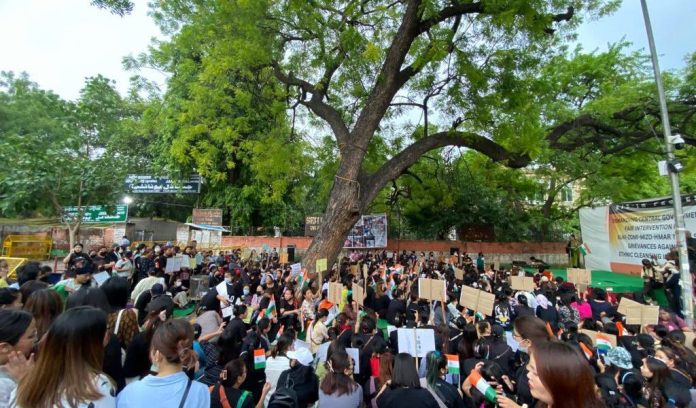NEW DELHI: Time and again, Northeast India is typecast as a topography of terror, a distant zone of “disturbed areas”. These are places where draconian policies like the Armed Forces Special Powers Act, 1958, or the AFSPA, are enforced, because it has a history of “law and order” problems. But what does it mean to look at a region and its people undergoing tumultuous pain and suffering, and be completely desensitised to its anguish?
What does it mean for communities within the same state, who have a fraught shared history, to lack any empathy for one another? How did the adoption of automatic rifles, ammunition, the brazen destruction of homes, neighbourhoods, and religious places become an acceptable “defence mechanism” in the desire to protect identity?
It has been almost three months since the first spark of civil strife that started on May 3 and over 160 people have died, more than 50,000 people have been displaced, and homes, cars, churches, and temples have been reduced to rubble. And these are only the reported numbers; it will be a long time, if ever, that we can begin to take stock of the scale and depravity of the entire situation.
We are only now getting to hear about the brutal manner in which two Kuki women were stripped, paraded naked, and one was raped by a Meitei mob, according to a first information report on the incident.
The state police were aware of this heinous crime but prioritised personal sectarian interests over the course of justice. The video and public reactions force one to critically engage with the causes and consequences of the brutal horrors and nightmarish agony that locals have had to experience for the past months.
What is alarming about the frightful incident of May 4 is that Meira Paibis have been key participants in fuelling mob violence in Manipur. These elderly women from the Meitei community are historically heralded as protectors of communities against “anti-social” elements and famed for their spectacular revolt against the military in 2004.
In the current hostile climate, it is the Kuki women’s bodies that were paraded as receptacles of communal identity, and savagely violated by the miscreants of the majority Meitei population.
Back in 2004, Meira Paibis gained international attention for their shocking protests against the military when they stripped naked in front of the historic Kangla Fort and held posters declaring “Indian Army Rape Us”. It was a gesture of angst and helplessness to express grief over the rape and murder by armed forces.
Why is only the graphic revolting image of naked women that attracts public attention to regions that are deemed too remote and peripheral?
Only after the violent rape and death of Manorama, there was some reaction from the national media, but even that was not enough to affect legislative changes. The state police were aware of this heinous crime but prioritised personal sectarian interests over the course of justice.
A clear distinction though is that Meira Paibis acted with agency and consented to the use of their body to articulate resistance against the state machinery. For those Kuki women, it was a gross violation of their bodies and psyche that was intentionally undertaken to inflict trauma and humiliation. As an act of subversion or an act of violation, the locus of aggressive identity politics is enacted on the naked woman’s body.
The violence against women shows a familiar pattern of events.
In 2019, a mob forcefully entered a party taking place in Utlou, Manipur and singled out the women (regardless of their community), paraded them, stripped them, and photos and videos of this distressing spectacle were widely circulated. But this grotesque incident did not shake the public consciousness, perhaps because the public stripping and parading of women was not dishonourable enough.
Meira Paibis forced their way into a private house party and accused them of dishonouring Manipuri culture. But it was the women who were dragged out, it was the women’s skirts that were tugged, the women’s bodies that were slapped and policed for drinking alcohol and wearing short clothes.
In the name of upholding culture, it was the women who faced the wrath of these gatekeepers of culture.
The question of ‘honour’ and ‘dishonour’, encapsulated in women’s bodies, is intensified in times of conflict. Rapes of women of the “other community” is lauded as a righteous course of action, to fulfill a self-aggrandising idea of punitive action. This notion hinges upon the act of ‘dishonouring’ or humiliating the other community. It is the sordid escalation of consistently dehumanising another community, of seeing the “other” as an abject enemy.
As legal and political dignitaries continue to debate the contours of indigeneity, the extent of affirmative action that the other community benefits from, it is civilians who burn in the ensuing crossfires. And it is women’s bodies that bear the marks of that confrontation. Even in the media reactions, the treatment has been steeped in patriarchal undertones.
This is an incident of “national shame”, inappropriate for any civilised society. This is the moment that invokes the paternal protection of the state as if earlier cries for peace and help amid atrocious mob violence did not warrant enough attention. It is only the notion of shame, of public humiliation that has elicited a response of deep remorse from all communities, finally uniting people in horror.
At last, we have earned the attention and words of condemnation from the prime minister.
National apathy and political inertia to the harrowing accounts from Manipur is a disturbingly familiar feeling.
In 2011, Anna Hazare’s 12-day hunger strike at Jantar Mantar was widely telecast on national television. In real time, his anti-corruption campaign resonated with the entire nation and an outraged, mobilised public put pressure on the parliament to swiftly make policy interventions. And yet Irom Sharmila, the woman from Manipur who was on a hunger strike since 2000, received no public sympathy for her campaign to repeal the draconian AFSPA.
She holds a record for the world’s longest hunger strike of 16 years – she was lauded as the ‘Iron lady of Manipur’, but there was no national outrage about the human rights violations in the region.
The law provides unparalleled “special” powers and legal impunity to military forces when either the state or the Centre declares places as “disturbed areas”. Empowered by the lack of judicial scrutiny, the law shields military forces from the human rights abuse and sexual violence that is unleashed even in cases of mere suspicion of militant activity.
Earlier this year, the jurisdiction of the law was reduced to limited districts in Assam, Manipur, and Nagaland. But the culture of impunity remains. It is this practice of legal and social impunity that entitles miscreants to engage in reprehensible actions and not fear legal or official action.
Sustained systemic practices of impunity have bred an atmosphere of utter distrust in legal and administrative justice. Systemic apathy, therefore, has cultivated a notion that the law does not work, or that one must go beyond the scope of law to combat the challenges of the region.
Decades of declaring these places as ‘lawless’ and ‘disturbed’ has only driven scant appreciation for legal mechanisms as communities turn to their own ways to secure their own interests and safety. It is the legacy of this systemic apathy that the sight of people running in fear, the plundering of homes and burning of vehicles, the needless deaths and countless vile conspiracies labelling entire communities as ‘illegal’, or militant groups could not stir any state or national intervention.
Where do we go from here? The state is ripped apart into fault lines of ethnically segregated neighbourhoods and there is a total breakdown of public trust. This collapse of communication and mutual support is not limited to only the Kuki and Meitei communities. It is also the crumbling away of trust in electoral leaders at both the federal and the Union level. It affects the larger region which is home to several other communities and how they witness the fallout of this conflict. It is the self-fulfilling prophecy that labelled the region as ‘disturbed’ and ‘lawless’, and did nothing as the hours of burnings, displacements and ceasefires protracted into days, and extended into months.
It took the delayed circulation of a gruesome video of sexual assault to jolt people, to catch national attention. And the reason we are only hearing of this outrage now is because there is a complete internet shutdown, on the premise that the ban will stop the spread of fake news.
But fake news continued to be spread and communal tension was incessantly stoked regardless of the internet ban. Ironically, it could only be with the use of the internet that the case has come to light and some semblance of remedial action has been possible. But by making the conversation about tribal and non-tribal identities, religious differences, and by laying contested claims to indigeneity and citizenship, the core issue remains unresolved.
At the heart of this strife is the question of claims to affirmative action for education, livelihoods, and resources. Restoring peace in the state requires acknowledgment and redressal of these deep-seated concerns and a clear commitment to the protection of all legal residents. Perhaps, it is true that the nation cannot see our grief and finds the ethnic divisions too banal for its attention. It will be up to our local communities to foster hope and reparation to build a better future than our past. –Agencies




